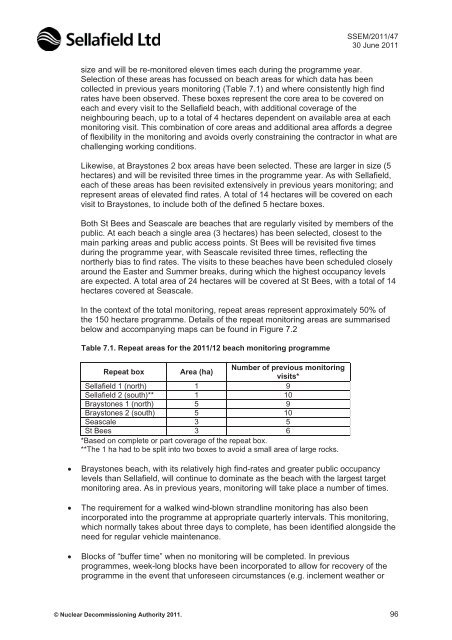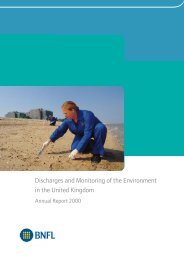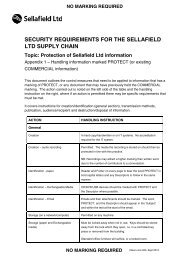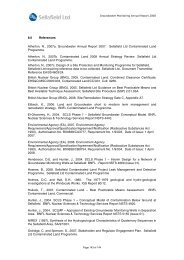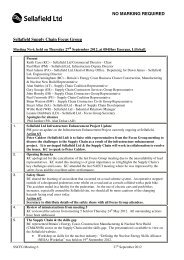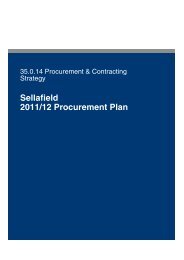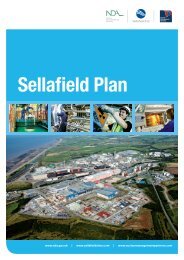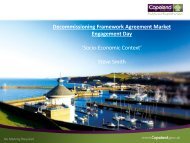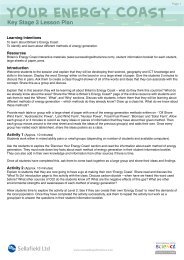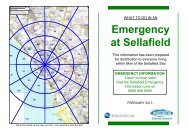Annual Report for 2010/11 and Forward Programme - Sellafield Ltd
Annual Report for 2010/11 and Forward Programme - Sellafield Ltd
Annual Report for 2010/11 and Forward Programme - Sellafield Ltd
Create successful ePaper yourself
Turn your PDF publications into a flip-book with our unique Google optimized e-Paper software.
SSEM/20<strong>11</strong>/4730 June 20<strong>11</strong>size <strong>and</strong> will be re-monitored eleven times each during the programme year.Selection of these areas has focussed on beach areas <strong>for</strong> which data has beencollected in previous years monitoring (Table 7.1) <strong>and</strong> where consistently high findrates have been observed. These boxes represent the core area to be covered oneach <strong>and</strong> every visit to the <strong>Sellafield</strong> beach, with additional coverage of theneighbouring beach, up to a total of 4 hectares dependent on available area at eachmonitoring visit. This combination of core areas <strong>and</strong> additional area af<strong>for</strong>ds a degreeof flexibility in the monitoring <strong>and</strong> avoids overly constraining the contractor in what arechallenging working conditions.Likewise, at Braystones 2 box areas have been selected. These are larger in size (5hectares) <strong>and</strong> will be revisited three times in the programme year. As with <strong>Sellafield</strong>,each of these areas has been revisited extensively in previous years monitoring; <strong>and</strong>represent areas of elevated find rates. A total of 14 hectares will be covered on eachvisit to Braystones, to include both of the defined 5 hectare boxes.Both St Bees <strong>and</strong> Seascale are beaches that are regularly visited by members of thepublic. At each beach a single area (3 hectares) has been selected, closest to themain parking areas <strong>and</strong> public access points. St Bees will be revisited five timesduring the programme year, with Seascale revisited three times, reflecting thenortherly bias to find rates. The visits to these beaches have been scheduled closelyaround the Easter <strong>and</strong> Summer breaks, during which the highest occupancy levelsare expected. A total area of 24 hectares will be covered at St Bees, with a total of 14hectares covered at Seascale.In the context of the total monitoring, repeat areas represent approximately 50% ofthe 150 hectare programme. Details of the repeat monitoring areas are summarisedbelow <strong>and</strong> accompanying maps can be found in Figure 7.2Table 7.1. Repeat areas <strong>for</strong> the 20<strong>11</strong>/12 beach monitoring programmeRepeat box Area (ha)Number of previous monitoringvisits*<strong>Sellafield</strong> 1 (north) 1 9<strong>Sellafield</strong> 2 (south)** 1 10Braystones 1 (north) 5 9Braystones 2 (south) 5 10Seascale 3 5St Bees 3 6*Based on complete or part coverage of the repeat box.**The 1 ha had to be split into two boxes to avoid a small area of large rocks.Braystones beach, with its relatively high find-rates <strong>and</strong> greater public occupancylevels than <strong>Sellafield</strong>, will continue to dominate as the beach with the largest targetmonitoring area. As in previous years, monitoring will take place a number of times.The requirement <strong>for</strong> a walked wind-blown str<strong>and</strong>line monitoring has also beenincorporated into the programme at appropriate quarterly intervals. This monitoring,which normally takes about three days to complete, has been identified alongside theneed <strong>for</strong> regular vehicle maintenance.Blocks of “buffer time” when no monitoring will be completed. In previousprogrammes, week-long blocks have been incorporated to allow <strong>for</strong> recovery of theprogramme in the event that un<strong>for</strong>eseen circumstances (e.g. inclement weather or© Nuclear Decommissioning Authority 20<strong>11</strong>. 96


